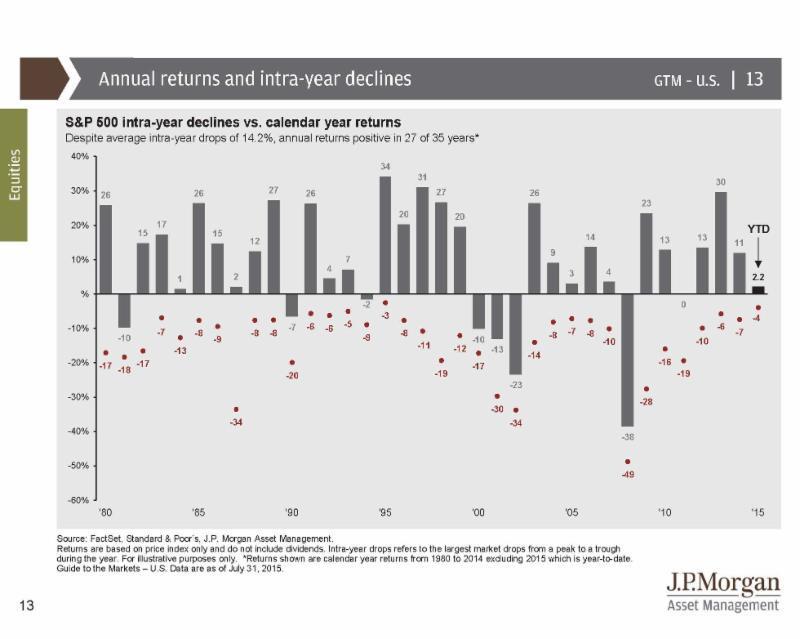
Recent Market Volatility
Given the world stock market volatility of the past few weeks, you are no doubt concerned and wondering whether we’re entering a period of extended declines. The answer to the question is we don’t know. No one does. We do know that the level, length, and eventual trigger of the end of the decline are all irrelevant things to ponder. Making long-term investment decisions based on short-term news is rarely a winning strategy. In times like these it’s important to remember that your investment portfolio has been built to carry you through decades, not days. This blog post is designed to provide some perspective and focus us on the long term, which is what matters most.
What is happening?*
The financial media loves to assign a “reason” for each and every drop in the market. A few weeks ago it was Greece, last year it was the Ebola scare, and two years ago the fiscal cliff. Right now the focus is on China and their slowing economy. The “reasons” will always be different but the important take-away is that markets frequently deal with uncertainty and re-price lower in the short term as they digest the new information. Eventually, in the long-term, the market fundamentals such as earnings will take over. This occurs because the world economy grows over time due to advances in innovation and technology, along with financial and human capital coming together to grow profits or create new products. Faith in these facts is essential, and over history, investors with diversified portfolios built on these facts have been rewarded. It’s possible for the stock of a single company to go to zero but the collective stock market won’t.
What should we do?**
The short answer is, “nothing.”
The longer, more involved answer starts with the fact that it’s important to remember that we aren’t 100% invested in the stock market. Most client portfolios have a healthy smattering of bonds, and every portfolio has a significant allocation towards alternative investments. Diversification may not seem like it works in the short run during event-driven declines, but allocating to different types of investments reduces volatility over the long-term.
Behavioral finance comes into play when markets are behaving in this fashion. Stock prices around the world are lower and presumably cheaper than a couple of weeks ago. But even though things are “on sale,” investors tend to flock for the exits rather than buying more shares. We love to buy everything on sale when we’re at the mall but seem to have a different mentality with stocks. On the flip side, when markets are doing well investors seem to have the urge to pile in and chase those prices higher. This behavior is counter-intuitive.
During times like these, we stay disciplined, keep our ownership in stocks, and check to see if we can rebalance portfolios to take advantage of the recent price drops. The rebalancing process forces us to buy more shares of stock funds at these lower prices. It doesn’t mean that the market can’t go lower – it surely can – but we’ll continue to take advantage of lower prices by accumulating more shares. Ultimately, this will allow the portfolio to regain its value more quickly when the market turns around.
Crashes, corrections, drawdowns, losses, system resets or whatever you want to call them are a feature of financial markets, not a sign they are broken. These things have to happen every once in a while for the system to function properly and wash out the excesses. We always learn from them and hopefully the “lifeboat drill” discussions we’ve had with you over the past year have prepared you for these events.
We’ve had a historic run in the stock market over the last six years. It’s easy to lose sight of the fact that it’s very normal to have intra-year declines in the 5-10% range. Five percent declines happen on average four times per year. Ten percent declines happen on average about once per year and have an average recovery period of about eight months. Unless one needs to spend all of their funds in the near future there is no reason to panic. Most of our clients have a time horizon for their money to last in excess of a decade, and the odds of losing money in a diversified portfolio over that time horizon are very low.
Over the weekend, JP Morgan put out the great chart below depicting the S&P 500 Index over the last 35 years, both in terms of its annual return and its intra-year decline. As you’ll see, even in the positive years it’s very common to have substantial intra-year declines. This year is no different.
The most important thing to us is your well-being. If the current stock market is causing you any loss of sleep or stress and you’d like to stop by our office or chat on the phone, please let us know. We welcome these conversations and want you to be as comfortable as possible.
*Credit to EKFF wealth management. ** Credit to Wealth of Common Sense


